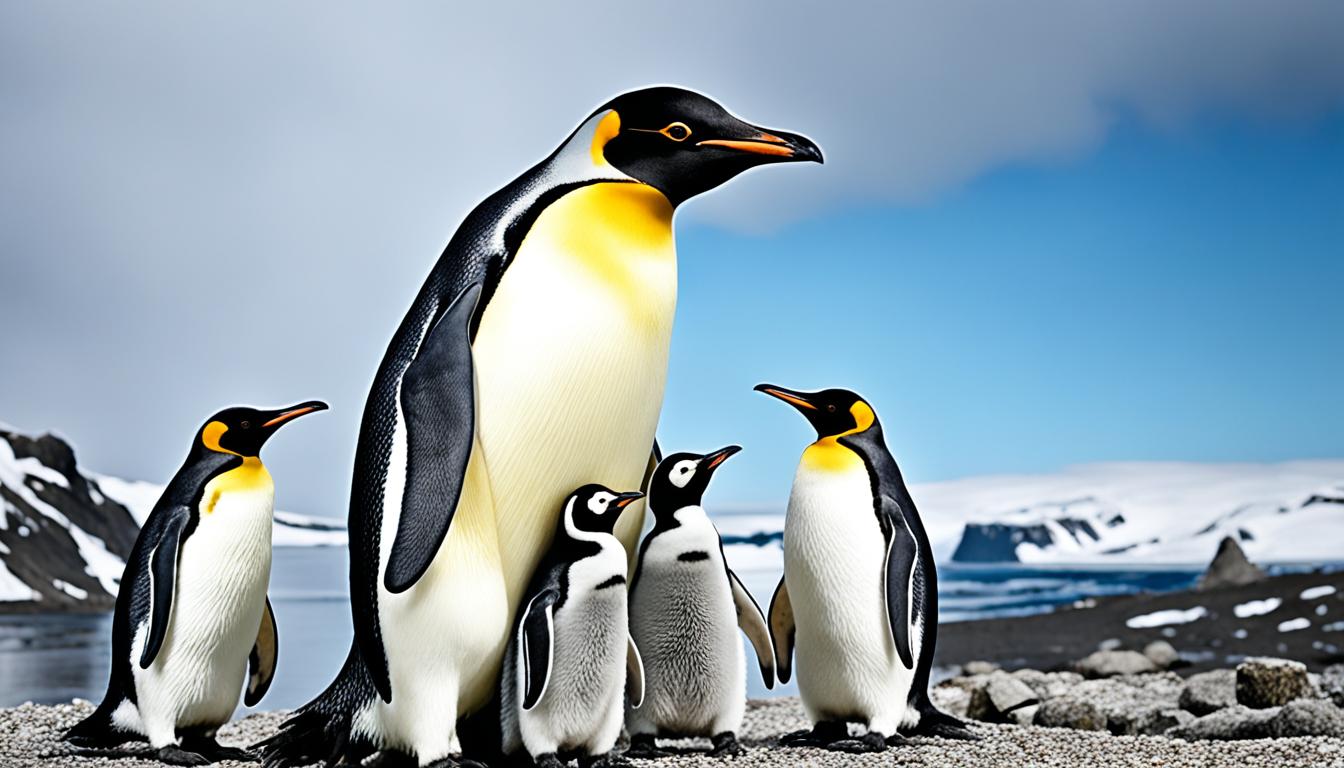Penguins are fascinating birds with a wide range of sizes. They adapt to different environments in unique ways. This article will look at the biggest and smallest penguins, showing a penguin size comparison. You’ll learn about the huge Kumimanu fordycei and the tiny Little Blue Penguin (Eudyptula minor).
These differences highlight how penguins have evolved to survive. Our penguin species size chart will show you more about these adaptations.
Understanding Penguin Sizes: An Overview
Penguins come in many sizes, each with its own special traits. Knowing about penguin height variations and penguin size comparison tells us a lot about their roles in nature. The different penguin sizes affect how they behave and adapt to their homes.
The Little Blue Penguin is the smallest, standing over 30 centimeters tall. On the other end, the Emperor Penguin can reach about one meter. These size differences affect how they stay warm and dive deep.
These size differences come from evolution, helping penguins live in different places. Bigger penguins have more fat for warmth and can dive deeper. Smaller ones are quick for catching food and avoiding predators. This variety makes penguins really interesting.
| Penguin Species | Average Height (cm) | Weight Range (kg) |
|---|---|---|
| Little Blue Penguin | 30 | 1.0 – 1.5 |
| Emperor Penguin | 100 | 25 – 40 |
| Adelie Penguin | 70 | 4 – 6 |
| King Penguin | 90 | 11 – 16 |
What are the largest and smallest penguin species?
Penguins come in all sizes, from the biggest to the smallest. These differences show how diverse and adapted these birds are. They tell us about their evolution over time.
The Largest Penguin Species: Kumimanu fordycei
Kumimanu fordycei was the biggest penguin that ever lived. It lived about 55 million years ago in New Zealand. It was as tall as 1.6 meters and weighed between 148 to 160 kilograms. This shows how penguins have changed in size over millions of years.
The Smallest Penguin Species: Little Blue Penguin (Eudyptula minor)
On the other end, the little blue penguin is the smallest. It’s about 30 centimeters tall and weighs just 1 kilogram. This shows how some penguins have adapted to live in different places.
Here’s a brief comparison of these two remarkable species:
| Penguin Species | Height | Weight |
|---|---|---|
| Kumimanu fordycei | 1.6 meters | 148 – 160 kg |
| Little Blue Penguin | 30 cm | 1 kg |
Comparing Penguin Size: The Emperor Penguin
The Emperor Penguin is a standout in the penguin world. It has unique traits that make it different from others. Its tall stature and special ways of surviving make it fascinating.
Emperor Penguin Characteristics
The Emperor Penguin, known as Aptenodytes forsteri, has a striking look with black and gold feathers. It’s well-suited for the harsh Antarctic climate. These penguins live together in large groups, showing strong social behavior.
They are known for their caring parents and how they work together to raise their young. Their social groups help them stay warm and safe in extreme weather.
Weight and Height of the Emperor Penguin
The Emperor Penguin is quite large, reaching about 1.2 meters (4 feet) tall and weighing up to 45 kilograms (99 pounds). This shows how different penguins can be in size. Their size also helps them dive deep to find food under the ice.
This makes them a key part of their ecosystem. Their size and weight are crucial for their survival and how well they hunt.
| Characteristic | Measurement |
|---|---|
| Average Height | 1.2 meters (4 feet) |
| Average Weight | 45 kilograms (99 pounds) |
| Species | Aptenodytes forsteri |
| Breeding Season | May to June |
Beyond the Present: Prehistoric Giants
Penguins have grown to be much bigger than what we see today. Palaeeudyptes klekowskii is a giant from the past that shows how these birds have evolved. It lived about 37 to 40 million years ago and was huge.
Palaeeudyptes klekowskii: The Colossus Penguin
Palaeeudyptes klekowskii was as tall as 2 meters and weighed around 115 kilograms. This makes it much bigger than today’s Emperor Penguin. Its size changes how we think about penguin size over time. It suggests a different way of life and environment than today’s penguins.
Kumimanu fordycei: A Newest Discovery in Size
Kumimanu fordycei is a new find that sheds light on penguin evolution. It adds to the penguin size chart with its size and weight. This giant penguin shows how past giants might have influenced today’s penguins. Studying these ancient penguins helps us understand their evolution and how they interacted with their environments.

Exploring Size Variations Among Penguin Species
Penguins show amazing size differences across various species. Their weight and height vary greatly. From the tiny Little Blue Penguin to the huge Emperor Penguin, we see these differences clearly.
Weight Diversity: From the Little Blue to Emperor Penguins
Penguins have a wide range of weights. The Little Blue Penguin is the lightest, weighing about 1 kilogram. On the other end, the Emperor Penguin can weigh up to 45 kilograms. These differences show how they adapt to different places and how they hunt and survive.
Height Differences: A Penguin Size Chart
Height also sets penguins apart. A size chart shows these differences clearly:
| Penguin Species | Average Weight (kg) | Average Height (cm) |
|---|---|---|
| Little Blue Penguin | 1 | 30 |
| Adelie Penguin | 3.5 | 70 |
| Chinstrap Penguin | 4.5 | 75 |
| Emperor Penguin | 45 | 120 |
This comparison shows how environment affects penguins’ size. It helps us understand their unique traits and behaviors.
Evolutionary Insights on Penguin Sizes
Looking into the history of penguins shows us why their sizes vary. Species like Kumimanu fordycei and Palaeeudyptes klekowskii are great examples. They show how penguins changed over time to fit their environments.
These big penguins from the past tell us a lot about their lives. They were huge, but they had reasons to be. We’ll explore why they got so big and how they managed to succeed.
Giant Penguins of the Past: Why Did They Thrive?
The big penguins were successful for many reasons. These included:
- Thermoregulation: Their size helped them stay warm in the cold, which was key for survival.
- Hunting Skills: Being big meant they could store more energy. This helped them hunt better in rich ocean areas.
- Reduced Predation: Being large might have scared off predators, giving them an advantage.
These giants show us how important the environment was in shaping their traits. Today’s penguins have changed because of climate shifts and new resources. To see how different penguins compare, here’s a penguin species size chart:
| Penguin Species | Average Height (inches) | Average Weight (lbs) |
|---|---|---|
| Kumimanu fordycei | 60 | 132 |
| Palaeeudyptes klekowskii | 48 | 74 |
| Emperor Penguin | 45 | 88 |
| King Penguin | 36 | 33 |
| Little Blue Penguin | 16 | 2.2 |
These stories of adaptation and pressure show us the complex history of penguin sizes. They’ve changed over millions of years to fit their environments.
Current Penguin Habitat and Size Adaptation
Penguins live in many places, from Antarctica’s ice to New Zealand’s coasts. Their size is closely linked to their environment. This shows how penguins adapt to their surroundings through size changes.
How Environment Influences Penguin Size
Many things affect how big penguins get. Food availability is a big factor. In places with lots of fish, big penguins do well because they can catch more food.
In areas with less food, smaller penguins are better off. They can move faster to find what they need. This shows how penguins adapt to their food sources.
Predators also play a role. In places with many predators, penguins might grow bigger for safety. But in safer spots, smaller penguins can do well without needing to be big.
Changes in the climate matter too. In cold places, bigger penguins help keep warm. This shows how their habitat affects their size. As the climate changes, penguins might adapt more to stay successful.
Interesting Facts About Penguin Size Differences
Exploring penguin size differences reveals their amazing diving skills. The Emperor Penguin, for instance, dives over 1,800 feet deep and can hold its breath for more than 20 minutes. This shows how size affects their survival in deep, cold waters.
Size also shapes their behavior during breeding seasons. Smaller penguins have shorter breeding cycles and can live in various places. This adds complexity to their lives.
Each penguin size has a special role in the ecosystem. Larger penguins help control fish populations. Smaller ones act as indicators of environmental changes. These facts show the vital role each penguin plays in its ecosystem.










